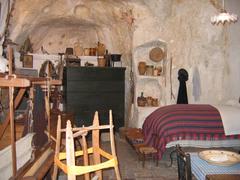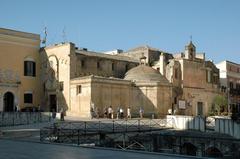San Pietro Barisano: Visiting Hours, Tickets, and Historical Sites in Matera, Italy
Date: 14/06/2025
Introduction
San Pietro Barisano is the largest rupestrian (rock-hewn) church in Matera, Italy, situated in the historic Sassi district. This monumental site embodies Matera’s extraordinary blend of religious, architectural, and cultural heritage. Carved out of soft calcarenite rock, San Pietro Barisano traces its origins to the early Middle Ages and has evolved through centuries, showcasing a unique architectural narrative from Byzantine and Romanesque influences to an 18th-century Baroque façade. The church’s enduring presence as the principal parish of the Sasso Barisano community highlights its vital role in Matera’s social and spiritual life. Today, San Pietro Barisano stands not only as a testament to the ingenuity of Matera’s inhabitants but also as an essential destination for visitors seeking to experience the city’s UNESCO-listed rupestrian landscape (Matera Turismo; Oltre l’Arte; hardcoreitalians.blog).
Historical Overview
Origins and Early Development
San Pietro Barisano’s roots stretch back to the 9th or 10th century CE, with documented references appearing by 1192. The church’s name likely derives from Bari settlers who established themselves in Matera during periods of political upheaval. As Matera’s population expanded, the church grew in both scale and importance, serving as the spiritual center of the Sasso Barisano district (Sassi di Matera).
Architectural Evolution
Rock-Hewn Construction
San Pietro Barisano exemplifies Matera’s rupestrian tradition, with its original nave, aisles, and chapels entirely excavated from stone. Over centuries, the church expanded above ground, integrating masonry elements to accommodate a growing congregation (Italia.it).
Romanesque and Baroque Influences
The 18th-century Baroque façade, completed in 1755, contrasts with the church’s ancient rock-cut interiors. The façade features a decorative portal and sculpted details, while the basilica plan inside—with three naves divided by stone columns—reflects Romanesque traditions. The now-partially collapsed bell tower once dominated the district’s skyline (Matera Cultura).
Multi-level Structure and Funerary Spaces
Beneath the main floor, crypts and burial chambers reveal the church’s funerary role. The putridarium, a unique feature where bodies decomposed before bones were transferred to ossuaries, provides rare insight into local burial customs (Lions in the Piazza).
Artistic Heritage
Frescoes and Iconography
Despite significant losses due to neglect and theft, important fresco fragments remain. Notably, the right nave’s chapel holds depictions of the Annunciation and saints such as St. Catherine of Alexandria, St. Augustine, and St. Vito, showcasing both Byzantine and Western artistic influences (Matera Sassi e Murgia; Oltre l’Arte).
Crypt Carvings and Decorative Elements
Within the crypts, mysterious carvings, sculpted seats, and fresco remnants reinforce the church’s dual function as a space of worship and commemoration (Tourist Secrets).
Loss and Restoration
Decades of abandonment led to the loss of many artworks. Since the Sassi’s UNESCO designation in 1993, restoration efforts have stabilized the church, preserved its frescoes, and improved visitor access (UNESCO; Bellas Bold Adventures).
Cultural and Religious Significance
San Pietro Barisano has long been the heart of Sasso Barisano’s spiritual life. It hosted major religious rituals, community festivals (especially the feast of Saint Peter), and significant rites of passage. Chapels and altars, often sponsored by prominent local families and confraternities, reflected the complex social structure of the Sassi (Matera Cultura).
San Pietro Barisano in Matera’s Historical and Urban Context
Located in the Sasso Barisano, the church illustrates Matera’s adaptation of the rocky landscape for residential, religious, and social use since prehistoric times. Its role within the UNESCO-listed Sassi underscores its importance in the city’s identity and modern cultural tourism (Italia.it; UNESCO).
Visitor Guide: Planning Your Visit
San Pietro Barisano Visiting Hours
- Standard Hours: 9:00 AM – 7:00 PM daily (last entry typically 6:30 PM)
- Seasonal Changes: Hours may vary for holidays or special events; always check with official sources before your visit (Matera Turismo; Oltre l’Arte).
Tickets and Admission
- Cost: ~€5 for adults, with discounts for students, seniors, and groups. Children under 12 often enter free.
- Where to Buy: Onsite or online via official ticketing platforms. Combo tickets may include other Sassi sites.
Guided Tours and Accessibility
- Guided Tours: Available in multiple languages, offering deep insights into the church’s artistry and history. Booking in advance is recommended.
- Accessibility: Level access and multimedia aids are available for visitors with disabilities, though some areas remain challenging due to the historic terrain (oltrelartematera.it; I Sassi di Matera).
Travel Tips and Getting There
- On Foot: 10–15 minutes from Piazza Vittorio Veneto through historic Matera streets.
- Public Transport: Buses do not serve the Sassi directly; taxis are available from the train station.
- Parking: Not permitted within the Sassi; use designated external lots.
- Best Time: Visit in spring or autumn for pleasant weather and fewer crowds; early mornings and late afternoons offer the best light (Earth Trekkers; Mama Loves Italy).
Site Experience and Visitor Conduct
- Duration: Allocate 30–45 minutes for a thorough visit.
- Photography: Non-flash photography is permitted; always check onsite guidelines.
- Respect: Dress modestly and maintain a quiet atmosphere inside.
Nearby Attractions
Enhance your experience by visiting the nearby Sassi districts, Casa Grotta di Vico Solitario, Palombaro Lungo cistern, and the Cathedral of Matera. Explore local artisan shops and cafes for authentic Materan cuisine and crafts (Puglia Guys).
Accessibility and Terrain
- Footwear: Wear sturdy shoes as the area features cobblestones and steep stairs.
- Mobility: Not recommended for wheelchairs or strollers due to uneven terrain.
- Facilities: Restrooms are limited; plan accordingly. Water, sunscreen, and weather-appropriate clothing are essential.
Special Events and Educational Activities
San Pietro Barisano hosts occasional cultural events, exhibitions, and community gatherings, especially significant since Matera’s selection as European Capital of Culture in 2019. Educational programs and interpretive materials are available, and the church features in films such as “The Gospel According to St. Matthew” and “The Passion of the Christ” (hardcoreitalians.blog).
Frequently Asked Questions (FAQ)
What are the visiting hours?
Typically 9:00 AM to 7:00 PM, with last entry at 6:30 PM. Always check current hours before your visit.
How much is admission?
Around €5 for adults, with discounts for students and seniors.
Are guided tours available?
Yes, in multiple languages. Advance booking is advised.
Is the church accessible for people with disabilities?
Some areas are accessible, but uneven terrain and stairs may limit access.
Can I take photographs inside?
Yes, generally without flash.
When is the best time to visit?
Spring and autumn are ideal; early morning or late afternoon for fewer crowds and optimal lighting.
Visuals and Suggested Media
- High-quality photos of the façade, interior frescoes, and crypts—use alt text such as “San Pietro Barisano church entrance in Matera Sassi,” “Frescoes inside San Pietro Barisano rupestrian church,” and “Crypt stairway at San Pietro Barisano.”
- Interactive maps and virtual tours are available on official tourism websites.
Responsible Tourism
- Stay on marked paths and respect restricted areas.
- Support local businesses for dining and shopping.
- Minimize waste and use reusable items.
Plan Your Visit and Stay Connected
For up-to-date visitor information, audio guides, and travel tips, download the Audiala app. Stay engaged with Matera’s cultural events and heritage news by following our social media channels.
Summary
San Pietro Barisano encapsulates Matera’s rich cultural legacy, blending centuries-old rock-hewn architecture with vibrant community life. Its unique history, multi-level structure, rare funerary features, and surviving frescoes make it a must-visit for travelers and scholars alike. With thoughtful planning and respect for local traditions, visitors can fully appreciate this remarkable UNESCO-listed landmark.
References
- San Pietro Barisano: Visiting Hours, Tickets, and History of Matera’s Largest Rupestrian Church, Matera Turismo
- San Pietro Barisano: Visiting Hours, Tickets, and Architectural Significance of a Matera Historical Site, Oltre l’Arte
- San Pietro Barisano: Visiting Hours, Tickets & Cultural Significance of Matera’s Largest Rupestrian Church, hardcoreitalians.blog
- San Pietro Barisano Visiting Hours, Tickets, and Visitor Guide | Matera Historical Sites, Puglia Guys
- UNESCO World Heritage Centre - Sassi di Matera
- Matera Cultura - Chiesa di San Pietro Barisano


